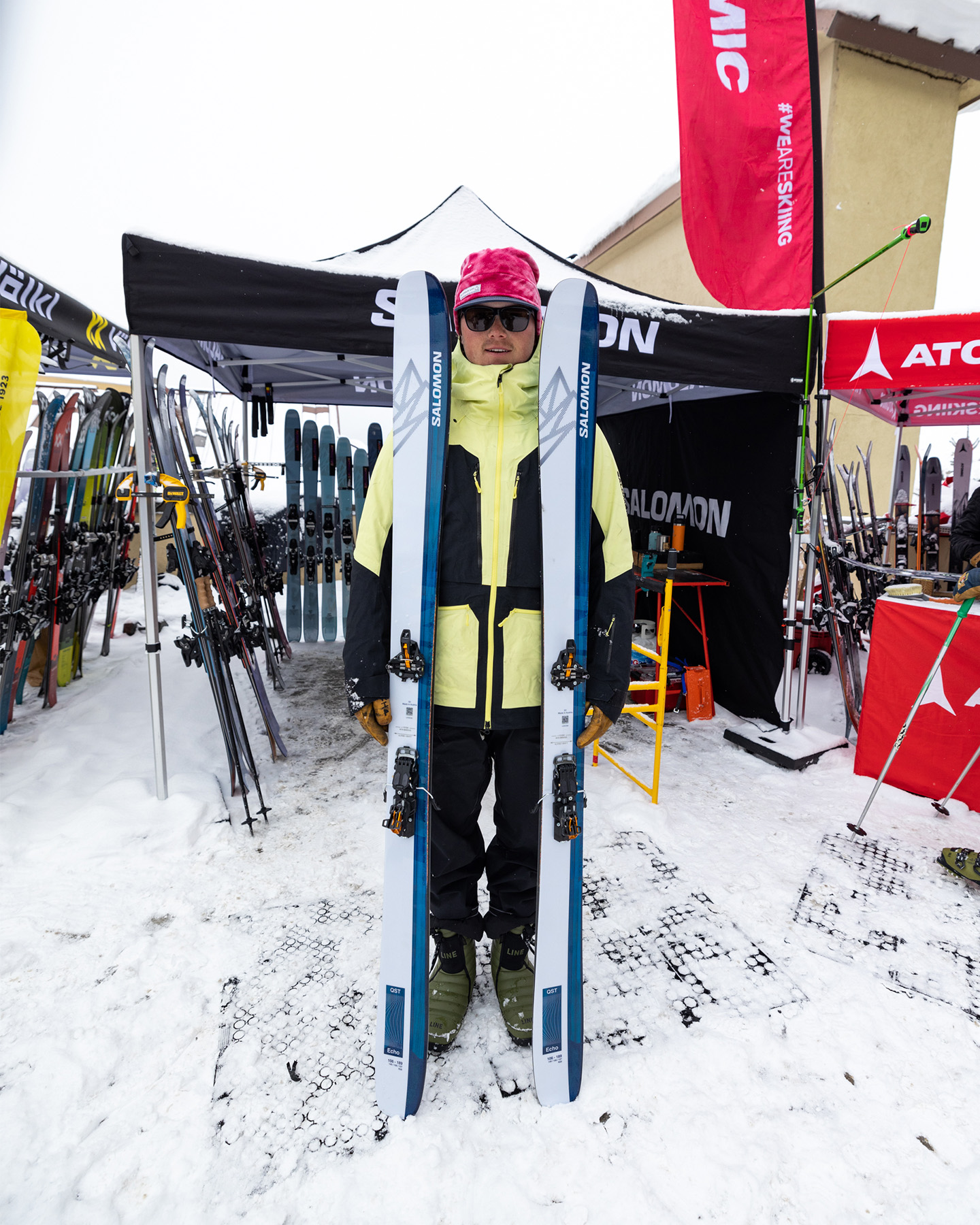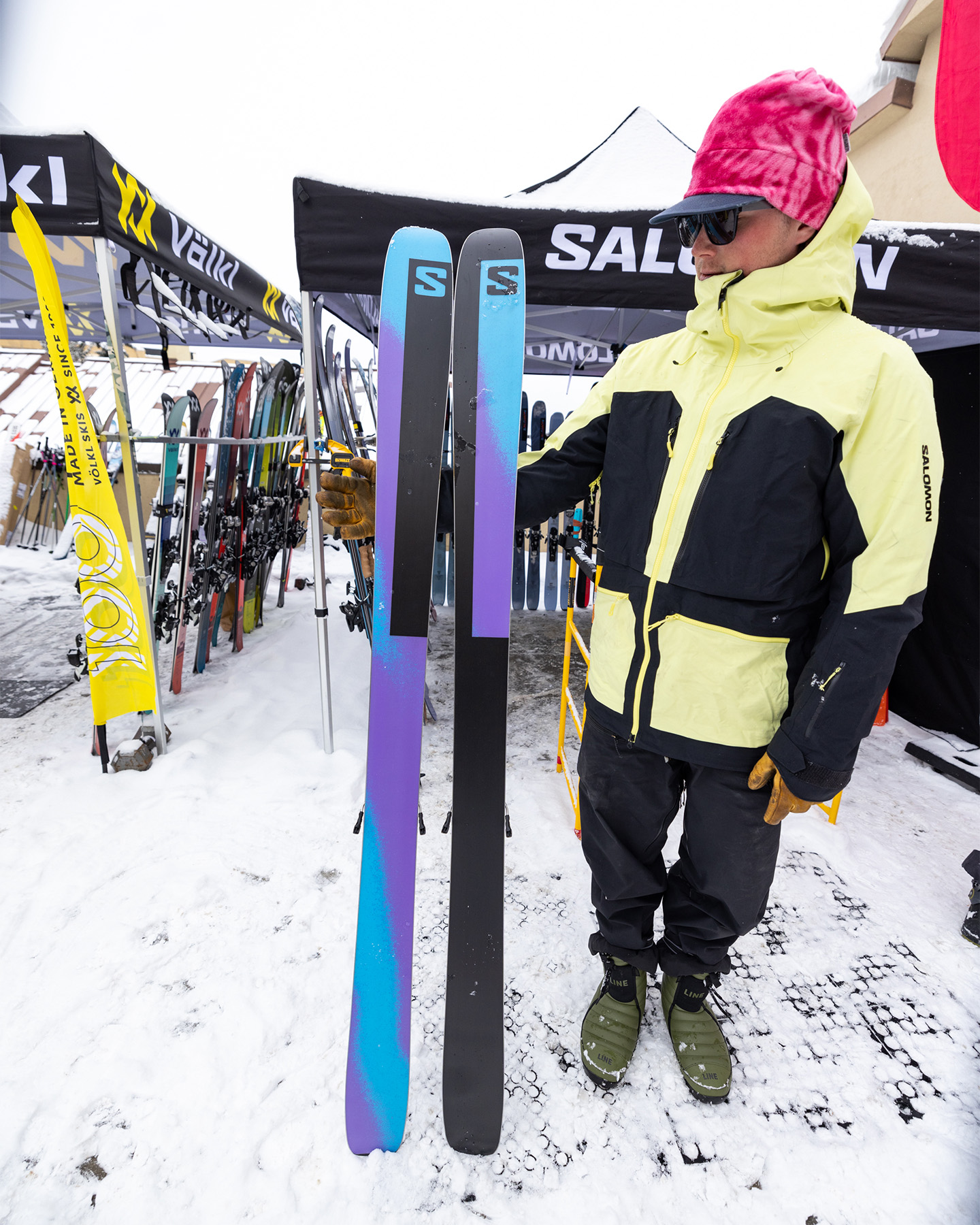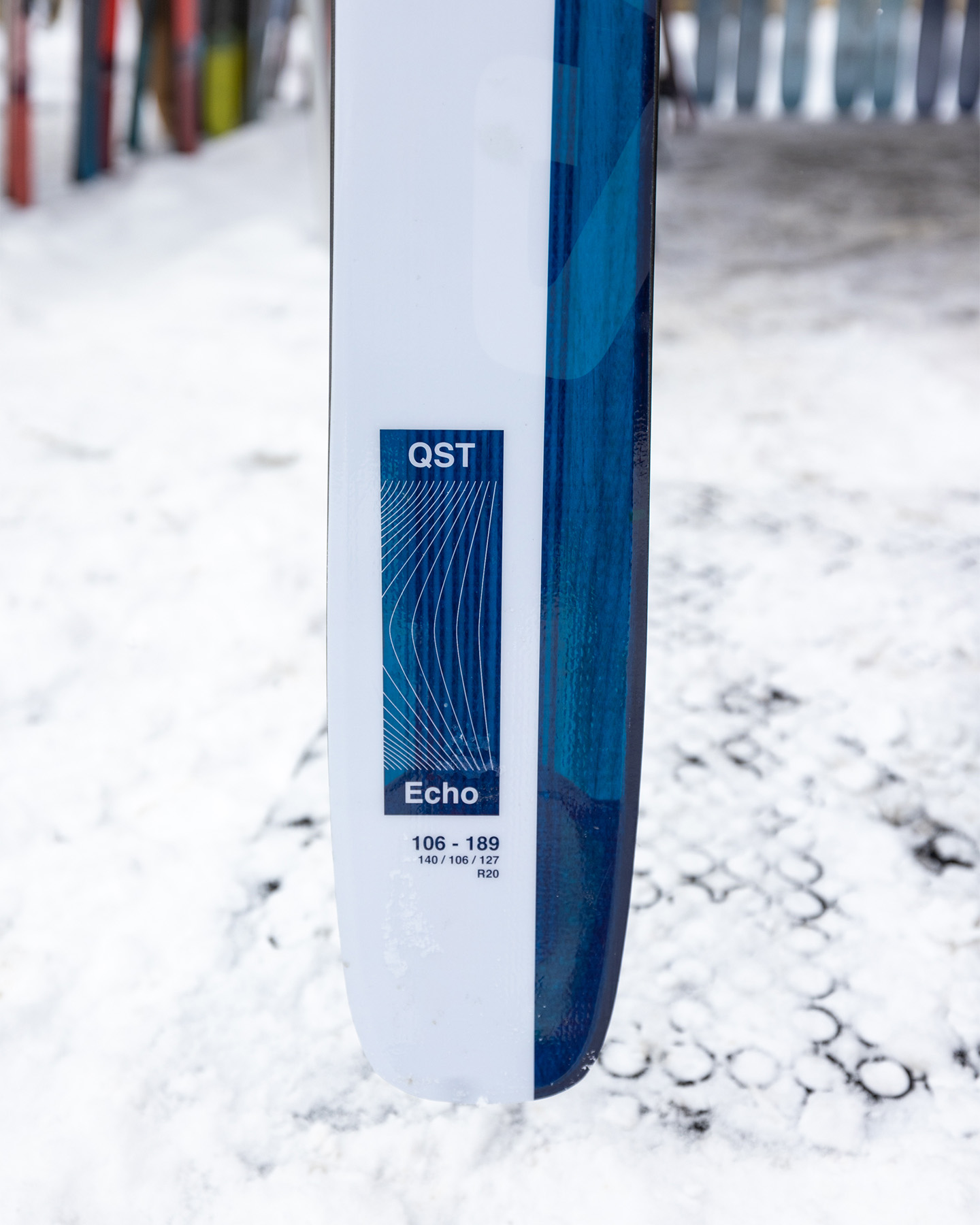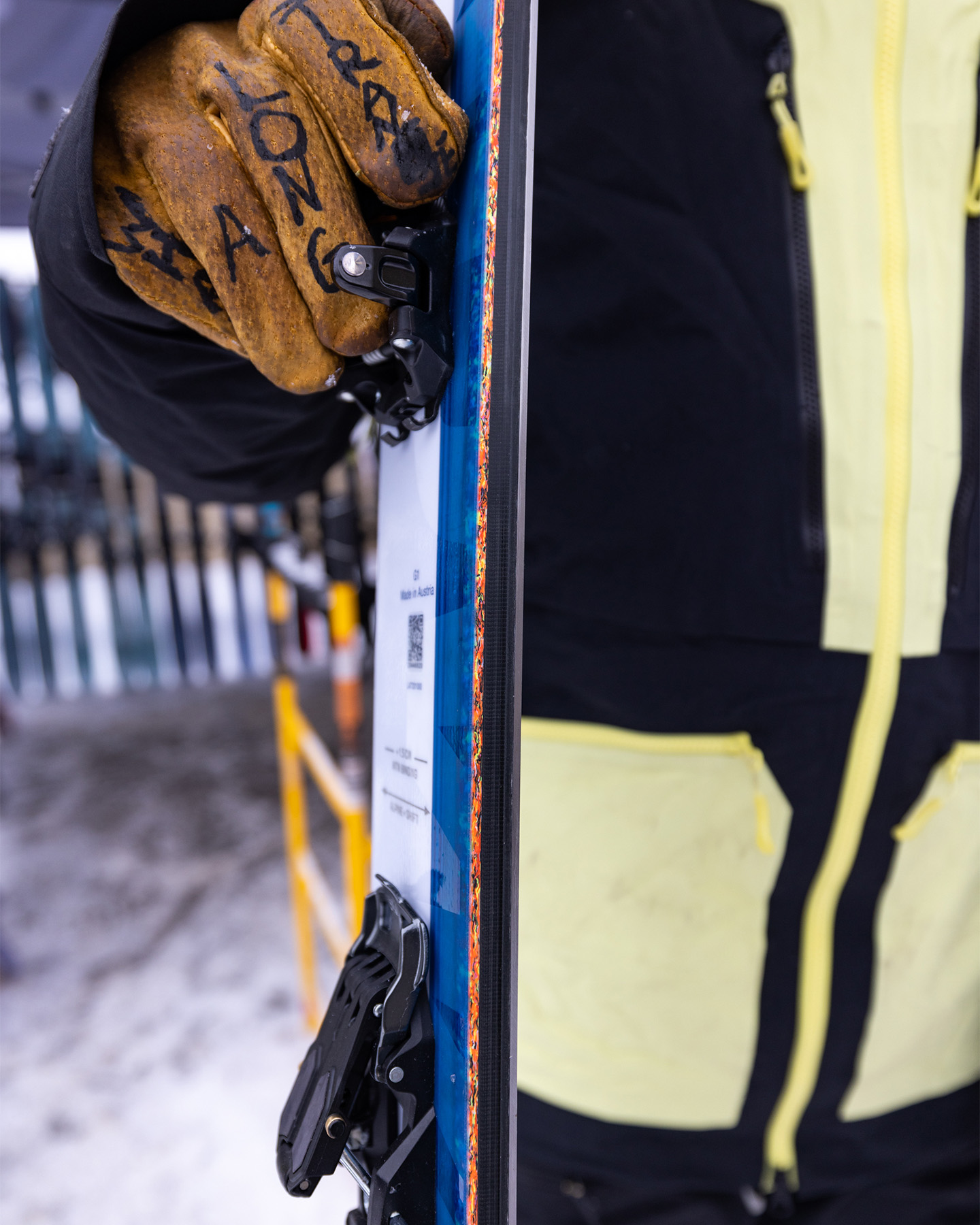Ski: 2023-2024 Salomon QST Echo 106, 181 cm
Available Lengths: 157, 165, 173, 181, 189 cm
Blister’s Measured Tip-to-Tail Length (straight-tape pull): 180.0 cm
Stated Weight per Ski (181 cm): 1760 grams
Stated Dimensions: 139-106-126 mm
Blister’s Measured Dimensions: 138.8-105.7-125.9 mm
Stated Sidecut Radius (181 cm): 19 meters
Measured Tip & Tail Splay (ski decambered): 54 mm / 26 mm
Measured Traditional Camber Underfoot: 4 mm
Core Materials: karuba / poplar + cork tips & tails + basalt & fiberglass laminate
Base: sintered
Factory Recommended Mount Point:
- “MTN Binding”: -8 cm from center; 82 cm from tail
- “Alpine + Shift”: -9 cm from center; 81 cm from tail

Intro
Today Salomon announced a new ski for the 2023-2024 season, the QST Echo 106, and if you’ve been keeping up on Cody Townsend’s Fifty Project, it’s likely that you’ve actually already seen it — just under some discrete prototype top sheets. As you might guess, this ski shares a lot in common with the standard Salomon QST 106, but the QST Echo 106 uses a lighter construction that makes it more ideal for human-powered days in the backcountry.
Our reviewers — and lots of attendees — have started testing the QST Echo 106 at the 2023 Blister Summit, and Blister Members can check out our initial on-snow impressions in our Flash Review. In the meantime, here’s the rundown on the design of the new ski.
What Salomon says about the QST Echo 106
“The all-new QST Echo 106 ski is a touring-specific addition to Salomon’s freeride-inspired QST range with a 106mm waist. Tested and refined by athlete Cody Townsend during the filming of The Fifty Project, this go-anywhere backcountry ski features a featherlight karuba/poplar core, basalt fibers, double sidewall technology and cork damplifier in the tip and tail. This combination produces a lightweight core that excels on the uphill. When paired with the uber versatile shape of the QST 106 you get a ski that also delivers confidence, stability and responsiveness regardless of conditions or terrain.”
Construction
The QST Echo 106 features a poplar / karuba wood core, “cork damplifier” inserts at the tips and tails, basalt fibers, and a fiberglass laminate. Compared to the standard QST 106, the QST Echo 106’s wood core is a bit lighter, its cork inserts are a touch smaller, and it ditches Salomon’s carbon / flax “C/FX” laminate for a slightly lighter basalt layer. The result is reportedly a ~300-gram weight difference; the QST Echo 106 also features 100% recycled ABS in the “Double Sidewall” and a top sheet material that’s 30% recycled.




Shape / Rocker Profile
If you’re familiar with the standard QST 106, the QST Echo 106 will look very familiar, given that the two skis share the same dimensions and are pressed in the same mold. Its tips and tails feature a notable amount of early tapering, and it has pretty deep tip and tail rocker lines for a ski of its width. By our measurements, the QST Echo 106 has slightly less tip and tail splay, but otherwise looks nearly identical to the standard QST 106.
Flex Pattern
Here’s how we’d characterize the flex pattern of the QST Echo 106:
Tips: 6
Shovels: 6-6.5
In Front of Toe Piece: 7-10
Underfoot: 10
Behind the Heel Piece: 10-8
Tails: 7.5-6.5
This flex pattern is quite similar overall to the regular QST 106, though the QST Echo 106 is notably softer at the tips and tails. It’s still quite stiff around the middle but the rockered portions of the ski are fairly soft.
Sidecut Radius
Pretty standard numbers here — at 19 meters for the 181 cm length, the QST Echo 106’s stated sidecut radius is maybe a touch shorter than average, but pretty usual for this class.
Mount Point
The QST Echo 106 has two recommended mount points: one at -8 cm from true center that’s labeled as for Salomon’s MTN touring binding, and another at -9 cm that’s marked “Alpine + Shift.” Both are fairly directional / rearward, but not super far back.
Weight
Salomon’s stated weight for the 181 cm QST Echo 106 is 1760 grams, which is quite light for this size of ski, but not the lightest in its class. There are some dedicated touring skis that are a bit lighter, and there are plenty of alpine skis that are notably heavier (including the standard QST 106). For reference, we weighed a pair of the 181 cm QST Echo 106 with Salomon’s MTN binding (with brakes) and they weighed around 2240 grams per ski+binding.
For reference, here are a number of our measured weights (per ski in grams) for some notable skis. Keep in mind the length differences to try to keep things apples-to-apples.
1337 & 1347 Movement Alp Tracks 106, 185 cm (20/21–21/22)
1362 & 1376 Scott Superguide 95, 178 cm (20/21–21/22)
1446 & 1447 Line Vision 98, 179 cm (19/20–21/22)
1469 & 1477 K2 Wayback 96, 177 cm (18/19–21/22)
1476 & 1490 K2 Wayback 106, 179 cm (18/19–21/22)
1477 & 1481 Majesty Superwolf, 178 cm (20/21–21/22)
1489 & 1545 G3 FINDr 102, 179 cm (19/20–21/22)
1543 & 1565 Salomon MTN Explore 95, 184 cm (16/17–21/22)
1556 & 1559 DPS Pagoda Tour 100 RP, 184 cm (20/21–21/22)
1577 & 1605 Scott Superguide Freetour, 185 cm (20/21–21/22)
1605 & 1630 Line Vision 108, 183 cm (19/20–21/22)
1606 & 1641 Blizzard Zero G 105, 188 cm (19/20–21/22)
1637 & 1647 Ronin 108, 185 cm
1642 & 1651 Renoun Citadel 106, 185 cm (19/20–21/22)
1671 & 1675 Weston Summit, 186 cm (20/21–21/22)
1690 & 1695 Nordica Enforcer Unlimited 104, 186 cm (22/23)
1705 & 1708 Wagner Summit 105, 185 cm (21/22)
1725 & 1774 Faction Agent 3.0, 180 cm (20/21–21/22)
1736 & 1767 4FRNT Raven, 184 cm (16/17–21/22)
1760 (stated weight) Salomon QST Echo 106, 181 cm (23/24)
1820 & 1821 Majesty Havoc Carbon, 186 cm (20/21–22/23)
1833 & 1894 Head Kore 111, 184 cm (22/23)
1863 & 1872 Atomic Bent 110, 188 cm (22/23)
1875 & 1881 Line Sir Francis Bacon, 184 cm (19/20–22/23)
1895 & 1906 Folsom Trophy Carbon, 188 cm (18/19–21/22)
1905 & 1919 J Skis Slacker, 188 cm (20/21–21/22)
1920 & 2006 RMU North Shore YLE 110, 186 cm (21/22–22/23)
1947 & 2011 4FRNT Devastator, 186 cm (20/21–22/23)
1951 & 1953 Elan Ripstick 106, 188 cm (20/21–22/23)
1964 & 1972 Moment Deathwish, 184 cm (19/20–20/21)
1970 & 1973 4FRNT Renegade, 184 cm (20/21–22/23)
1970 & 1993 Moment Deathwish 104, 184 cm (21/22–22/23)
1973 & 2005 WNDR Alpine Intention 110, 185 cm (21/22)
1993 & 2026 Black Crows Atris, 184.2 cm (19/20–21/22)
1997 & 2003 WNDR Alpine Intention 108, 188 cm (22/23)
2008 & 2065 Wagner Summit 106, 186 cm (20/21–22/23)
2011 & 2028 Moment Wildcat 108, 184 cm (19/20–20/21)
2011 & 2046 Elan Ripstick 106 Black Edition, 188 cm (21/22–22/23)
2027 & 2052 K2 Reckoner 112, 184 cm (20/21–22/23)
2034 & 2052 Blizzard Rustler 11, 188 cm (17/18–21/22)
2046 & 2120 Black Crows Corvus, 188 cm (18/19–22/23)
2060 & 2075 4FRNT Hoji, 184 cm (21/22–22/23)
2096 & 2100 Salomon QST 106, 181 cm (19/20–21/22)
2110 & 2119 Moment Wildcat 108, 190 cm (19/20–20/21)
2112 & 2125 4FRNT MSP 107, 187 cm (18/19–22/23)
2116 & 2181 Faction Dictator 3.0, 188 cm (19/20–21/22)
2145 & 2167 Sego Big Horn 106, 187 cm (20/21–21/22)
2153 & 2184 Rossignol BLACKOPS Sender Ti, 187 cm (20/21–21/22)
2165 & 2211 K2 Mindbender 108Ti, 186 cm (19/20–21/22)
2165 & 2219 Icelantic Nomad 105, 191 cm (19/20–20/21)
2170 & 2180 Dynastar M-Free 108, 182 cm (20/21–22/23)
2171 & 2191 Wagner Summit 109, 186 cm (22/23)
2182 & 2218 Nordica Enforcer 110 Free, 185 cm (17/18–22/23)
2228 & 2270 Sego Comp 110, 187 cm (20/21–21/22)
2232 & 2242 Blizzard Cochise 106, 185 cm (20/21–22/23)
2243 & 2287 Salomon QST Blank, 186 cm (21/22–22/23)
2258 & 2303 Wagner Summit 107, 186 cm (21/22–22/23)
2295 & 2344 J Skis Hotshot, 183 cm (20/21–21/22)
2302 & 2342 Dynastar M-Free 108, 192 cm (20/21–22/23)
2312 & 2386 Prior Husume, 188 cm (17/18–21/22)
2353 & 2360 Volkl Katana 108, 184 cm (20/21–22/23)
2449 & 2493 J Skis Hotshot, 189 cm (20/21–21/22)
Some Questions / Things We’re Curious About
(1) The QST Echo 106 and standard QST 106 share a lot in common, aside from weight. So just how similar do they feel on snow?
(2) The QST Echo 106’s weight falls in line with many touring skis, but given how light many alpine skis are these days, it’s also not drastically far off from some inbounds-oriented options. So should this be viewed as a purely human-powered ski, or one that can handle some days of skiing variable snow in the resort?
Bottom Line (For Now)
The Salomon QST Echo 106 takes the very versatile QST 106 platform and applies it to a lighter, more touring-friendly package. That sounds like an appealing combo, and we’ve been spending time on it — Blister Members can check out our Flash Review to see what we’ve found so far.
Flash Review
Blister Members can read our Flash Review of the QST Echo 106 for our initial on-snow impressions. Become a Blister member now to check out this and all of our Flash Reviews, plus get exclusive deals and discounts on skis, and personalized gear recommendations from us.


I’m intrigued by the idea of mounting tech bindings differently. It’s not something I’ve ever considered or encountered, but it makes sense that with the extreme ramp angles we tend to see on tech bindings, the ideal mount might differ. I’d love to see blister investigate/discuss this more.
I think that the more forward mount point for pin bindings is intended to compensate for softer boots and therefore reduced leverage over the tip. I make similar adjustments when mounting my own skis, for example when I switched my Faction La Machines from Shifts to Freeraiders I repositioned from -11 to -10 cm (note that both of those are further back than Paul chose for that ski, though).
If you were compensating for high ramp angle alone you would mount further back (the opposite of what Salomon is doing here), since high ramp angles tend to put your center of mass farther forward over the ski. Also, not all AT bindings have high ramp angles.
A large portion of that is because when you mount the binding further forward you get better grip when skinning. Those who put a pin binding on will be doing more uphill so more grip is more important.
Hello,
What size brakes did you mount? Was it 100, or 110?
Cheers
No skin clip cutout on the tail. I don’t get it.
I was thinking the same thing! I’ve added notches in the tails of some of my skis and I no longer have to stop and re attach my skin clips any more! Total game changer.
Every company seems to be creating touring skis by putting touring cores in their inbounds skis. At the risk of stating the obvious, snow conditions in a resort and in the backcountry are fundamentally different. From tip taper to sidecut lengths and rocker profiles, the shapes that work well in resort conditions often don’t translate to the funky 3 dimensional snow you commonly ski in the backcountry. For example, if you’re looking for stability in the resort, you’re talking about keeping a ski tracking through other tracks, chop, or bumps and as blister has hammered for a long time, you’re best served by a shape with little or no tip taper. But in funky 3d snow in the backcountry, where you’re trying to keep a ski tracking through wind affected, sun affected weirdness, that same lack of taper can cause a tip to hook up in all kinds of strange ways as snow density and depth change from turn to turn. I think a tapered tip shape can keep a ski tracking more predictably in those conditions, and since you’re (hopefully) not crossing tracks and certainly not skiing chop, the deflection you’d experience in resort snow isn’t happening and I actually feel like tip taper can make a ski feel more stable. My 2 cents…
/rant
But the QST line already has some pretty good taper, so that might be part of it.
As I was looking at the weight list, at first I thought, it was heavy, being the heaviest touring ski on the list.
But then I looked closer and the next lighter ones are only a few grams lighter, really not much in the grand scheme of things.
Instead of a list, it would be nice to see this info as a bar chart, that allows one to instantly see water a bunch of skis are very similar, or much heavier or lighter.
I also think the comparison can be much smaller. No need to list narrower or wider skis, nor the very heaviest resort skis, when looking at a touring ski.
Sounds a bit like a return to the weight and purpose of the first generation of QST 106. It was significantly lighter back then compared to the current iteration. It’s my touring ski and a great backcountry ski, though it’s not made for straightlining through resort snow.
My question is this: which would you choose, a QST 106 in 181 or an Echo in 189?
Sounds like they brought back the original (orange) qst.
+ 2240 for the 181 with mtn binding (300ish grams) = 1940 per ski. Another blizzard hustle scenario ?
Mine (181) are well over 1800g. I don’t really mind though.
Which mounting point are you guys skiing in these? I am at -9 but wondering whether I should move to the “touring” mark at -8. For Reference, I have my ATKs shimmed to a 4mm delta and like tonski through my feet without driving the tips all that hard. At the Moment, I feel like I lack control over the tips a little. Does moving forward soundime a good approach? Thanks!
When I experienced my tips pushing me up and over in the backcountry I tried moving my bindings ahead +2cm. It did wonders, the ski now feels evenly distributed between tip/tail and is more maneuverable.
Also, regarding no skin notch in tail, this is not a problem. I cut out my own notches to suit the width of my skin tail. Easy job that takes less than a half hour. A sharp file is all you need, a hacksaw for 2 side cuts per ski makes it even easier.
Two seasons of heavy use and still i think these are amazing skis. And the third season started on heavy dump and again I’m am stunned how capable are these skis. Good job, Cody!